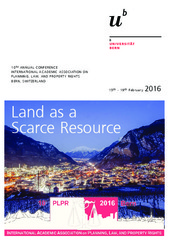Приказ основних података о документу
Urban Patterns of Housing in Post‐Socialist Serbia: Between Planning, Law and Reality
| dc.creator | Antonić, Branislav | |
| dc.creator | Djukić, Aleksandra | |
| dc.date.accessioned | 2020-06-16T12:21:14Z | |
| dc.date.available | 2020-06-16T12:21:14Z | |
| dc.date.issued | 2016 | |
| dc.identifier.uri | https://raf.arh.bg.ac.rs/handle/123456789/977 | |
| dc.description.abstract | Housing has always been considered to be a very complex urban function, where the social aspect of private-life sensitivity confronts the economic fact of every housing unit as a commodity. This confrontation is even more significant if it is known that housing is also the spatially most demanding urban function, usually exceeding city limits and tackling both the urban and regional level. Thus, every society tries to make a balance of these aspects of housing through various measures in legislation, planning and property management. But, what happens when this balance stops working? A good example is present-day Serbia, as a typical post-socialist country with many unexpected and sudden “transitional” changes. The consequences are fragile and underdeveloped legislative, planning and strategic systems in Serbia, which are the important culprits for the present state in housing. For example, the main legislative act, the national law on housing is very old for transitional circumstances; it has had more than 15 amendments since the adoption in 1992. Many of its elements are obsolete now. The law on social housing is new, but, regarding to very modest funds, it is without much effect in reality. Further, the law on national spatial plan of Serbia does have separate charter of housing; it is included in the charter of social development. Next, national housing policy does not exist as a separate unity. This situation makes huge confusion in the implementation. Nevertheless, these influences have formed specific urban patterns, very noticeable in Serbian cities and their suburbia. The crucial ones are: the simplification of the housing typology, scarcity of social-housing urban models and still vivid informal housing on the outskirts of Serbian cities. Hence, their influence on future urban and regional development in Serbia is unavoidable. This realization is the main reason for the research. Therefore, it aims to analyse and understand how housing-related legislative and planning documents have influenced the current urban patterns of housing in Serbian cities. The first step in achieving this would be the selection of appropriate legislative and planning documents. Next, their elements related to the urban dimension of housing will be compared with the current urban patterns in Serbian cities. The mentioned comparison through relevant elements will be the foundation for the expected results, which will try to clarify which specificities of the local urban patterns can be used as possible tools for the improvement of the Serbian legislative and planning system. | en |
| dc.language.iso | en | sr |
| dc.publisher | University of Bern | sr |
| dc.relation | info:eu-repo/grantAgreement/MESTD/Technological Development (TD or TR)/36034/RS// | sr |
| dc.relation | info:eu-repo/grantAgreement/MESTD/Technological Development (TD or TR)/36035/RS// | sr |
| dc.rights | openAccess | sr |
| dc.rights.uri | https://creativecommons.org/licenses/by/4.0/ | |
| dc.source | Land as a Scarce Resource, 10th Annual Conference International Academic Association on Planning, Law, and Property Rights Bern, Switzerland, 15th - 19th February 2016 | sr |
| dc.subject | Housing | sr |
| dc.subject | Urban patterns | sr |
| dc.subject | Post-socialist urbanism | sr |
| dc.subject | Urban legislation | sr |
| dc.subject | Serbia | sr |
| dc.title | Urban Patterns of Housing in Post‐Socialist Serbia: Between Planning, Law and Reality | en |
| dc.type | conferenceObject | sr |
| dc.rights.license | ARR | sr |
| dcterms.abstract | Дјукић, Aлександра; Aнтонић, Бранислав; | |
| dc.rights.holder | University of Bern | sr |
| dc.identifier.fulltext | https://raf.arh.bg.ac.rs/bitstream/id/2844/PLPR16_Antonic_Djukic.pdf | |
| dc.identifier.rcub | https://hdl.handle.net/21.15107/rcub_raf_977 | |
| dc.type.version | publishedVersion | sr |

